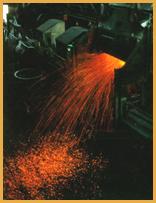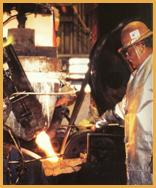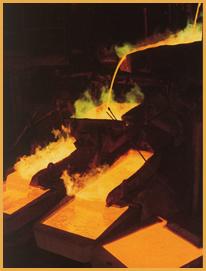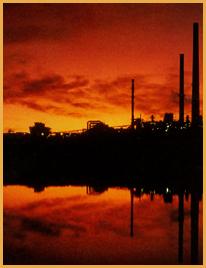Millions of Dollars Saved With Non-Traditional Shutdown Procedures
Copper Applications in Mining & Extraction
 In the small town of San Manuel, Arizona, 50 miles outside Tucson, is one of the world's largest and most productive copper smelters. USA Today and the Rochester Institute of Technology have recognized the San Manuel Smelter Rebuild Team for their design and successful execution of the precedent setting "seven-day mini-shutdown." These mini-shutdowns have saved millions of dollars each year over the standard shutdown of 45-60 days. San Manuel is preparing for a major shutdown in 1998. Successfully managing the risk of not rebuilding the smelter for ten years, has awarded us worldwide recognition for the creation of a new model for keeping a smelter running.
In the small town of San Manuel, Arizona, 50 miles outside Tucson, is one of the world's largest and most productive copper smelters. USA Today and the Rochester Institute of Technology have recognized the San Manuel Smelter Rebuild Team for their design and successful execution of the precedent setting "seven-day mini-shutdown." These mini-shutdowns have saved millions of dollars each year over the standard shutdown of 45-60 days. San Manuel is preparing for a major shutdown in 1998. Successfully managing the risk of not rebuilding the smelter for ten years, has awarded us worldwide recognition for the creation of a new model for keeping a smelter running.
A Crisis
 It was a crisis that gave birth to this new world precedent for smelter shutdowns. It was generally accepted that approximately every two or three years smelters would shut down for 45-60 days so that furnace bricks could be replaced along with other ancillary equipment. For a San Manuel shutdown, one half million dollars a day would be lost in revenue, and another $1 million a day would be spent for the maintenance work.
It was a crisis that gave birth to this new world precedent for smelter shutdowns. It was generally accepted that approximately every two or three years smelters would shut down for 45-60 days so that furnace bricks could be replaced along with other ancillary equipment. For a San Manuel shutdown, one half million dollars a day would be lost in revenue, and another $1 million a day would be spent for the maintenance work.
These figures presented an enormous dilemma for the San Manuel operators in late 1990 when the smelter (owned by Magma at the time) was approaching the two-year mark for a traditional 45-60 day shutdown. A prolonged shutdown meant concentrate from the company's mines would have to be exported to Japan. The additional cost of freight and Japanese processing fees would have hurt the company's cash flow and earnings.
The Solution
 Let's start at the beginning. San Manuel's original furnace was constructed in 1955 when reverberatory furnaces were the heart of copper smelting. In 1988, Newmont Mining Company (the owner before Magma) invested $149 million to replace the old furnace with a new Outokumpu flash smelting furnace. Concentrate treatment capacity would be expanded to a million tons a year and capture 98 percent of the sulfur.
Let's start at the beginning. San Manuel's original furnace was constructed in 1955 when reverberatory furnaces were the heart of copper smelting. In 1988, Newmont Mining Company (the owner before Magma) invested $149 million to replace the old furnace with a new Outokumpu flash smelting furnace. Concentrate treatment capacity would be expanded to a million tons a year and capture 98 percent of the sulfur.
The design skills of San Manuel's smelter operators were put to the test in order to keep the old smelter on-line for so many years. "Our operators had to be creative and come up with new designs and new approaches. Many of their ideas were used in the design of the new Outokumpu furnace, including the flash furnace roof design," said J. D. McCain, who recently retired as Vice President Operations.
Operating the new smelter was an enormous challenge in its first year, and the smelter had frequent shutdowns. With additional modifications, and increased operator experience, in 1990 the one million tons of concentrate mark was hit with almost no interruptions. But the dreaded traditional point for a 45-60 day shutdown was approaching rapidly, and the company couldn't afford it.
 Workers were challenged to think beyond traditional maintenance and operating practices and come up with a solution. To prevent the substantial loss in revenue from a major shutdown, the decision was made to do what no one in the smelting industry had done before-postpone the shutdown for a full year.
Workers were challenged to think beyond traditional maintenance and operating practices and come up with a solution. To prevent the substantial loss in revenue from a major shutdown, the decision was made to do what no one in the smelting industry had done before-postpone the shutdown for a full year.
Everyone held their breath hoping there would be no major problems-and there were none!
Most smelters shut down every two years for a major rebuild because the operators don't want to risk the enormous problems that might result without a rebuild. Managing risk means evaluating not shutting down the smelter and being exposed to the possibility of a catastrophic failure of the plant.
Innovative Seven-Day Shutdown
 Key to the success of avoiding major shutdowns was the design of the seven-day mini-shutdown to rebuild only critical sections of the plant. At the time, many people felt that after shutting down for only seven days, additional equipment deterioration would be identified that would require extending the shutdown for many more days, if not weeks. But, the shutdown team delivered a seven-day shutdown on-budget and on-time, and the worldwide smelting community took notice. Recognition even came from outside the smelting industry when USA Today and the Rochester Institute of Technology complimented the San Manuel Smelter Rebuild Team for their design and successful execution of the precedent setting seven-day mini-shutdown. Year after year, the risk of a major shutdown was weighed against the value of staying on-line, and year after year the cost-saving mini-shutdown won out. This decision saved the company tens of millions of dollars annually and helped increase smelter production to almost 1.3 million tons of concentrate annually, a 79 percent increase from 1988.
Key to the success of avoiding major shutdowns was the design of the seven-day mini-shutdown to rebuild only critical sections of the plant. At the time, many people felt that after shutting down for only seven days, additional equipment deterioration would be identified that would require extending the shutdown for many more days, if not weeks. But, the shutdown team delivered a seven-day shutdown on-budget and on-time, and the worldwide smelting community took notice. Recognition even came from outside the smelting industry when USA Today and the Rochester Institute of Technology complimented the San Manuel Smelter Rebuild Team for their design and successful execution of the precedent setting seven-day mini-shutdown. Year after year, the risk of a major shutdown was weighed against the value of staying on-line, and year after year the cost-saving mini-shutdown won out. This decision saved the company tens of millions of dollars annually and helped increase smelter production to almost 1.3 million tons of concentrate annually, a 79 percent increase from 1988.
BHP's Smelter Shutdown Modeled
Other copper smelters have recognized the shutdown accomplishments of BHPs smelter and are beginning to model the concept of deferring major shutdowns. This will have the effect of increasing world-wide smelter capacity without constructing new smelters. This capacity, in many cases, is available to BHP who relies on custom smelters to process the majority of its concentrate.
Finally a Major Shutdown
 After almost ten years the time has finally arrived. A major rebuild of 45-60 days is scheduled for March-April 1998. Our objective is to have no more than a 45 day shutdown. A shutdown of 45 days instead of 60 will save BHP in excess of $10 million. The most recent comparable rebuild was the 1993 rebuild of the Phelps Dodge Outokumpu flash smelting furnace in New Mexico which lasted 59 days. In 1995 similar furnaces at Atlantic Copper in Spain and at BCL in Botswana also took over 50 days. Successful rebuild of the San Manuel flash furnace in only 45 days will be a real challenge, but one we are making careful preparations to accomplish safely and on schedule.
After almost ten years the time has finally arrived. A major rebuild of 45-60 days is scheduled for March-April 1998. Our objective is to have no more than a 45 day shutdown. A shutdown of 45 days instead of 60 will save BHP in excess of $10 million. The most recent comparable rebuild was the 1993 rebuild of the Phelps Dodge Outokumpu flash smelting furnace in New Mexico which lasted 59 days. In 1995 similar furnaces at Atlantic Copper in Spain and at BCL in Botswana also took over 50 days. Successful rebuild of the San Manuel flash furnace in only 45 days will be a real challenge, but one we are making careful preparations to accomplish safely and on schedule.
BHP's Advantage
Key to the rebuild's success is the exceptional rebuild team that is being assembled. Members of the team will be drawn from the smelter operations, site engineering groups, BHP Engineering, BHP Steel and BHP Manganese. BHP Engineering and BHP Steel engineers have accumulated considerable experience over a number of years in high intensity shutdowns of steel plants, as well as experience working in integrated teams and partnership arrangements. Few, if any, companies in the world have the capability of assembling a team with such vast and relevant experience.
BHP Shareholders Benefit
After next year's major rebuild, the San Manuel smelter will operate for another 10 years on mini-shutdowns. This strategy will save BHP roughly $200 million over the next 10 years before the next major rebuild, resulting in more cash flow and value for BHP ![]()
Craig Steinke is Group General Manager and Senior Vice President of Metals in San Francisco and Pj Cannon, an Assistant Editor for On Cu.
This article is reprinted with permission from the publication,
On CU, April – June, 1997,Vol. 1, No. 3.
| On CU is the quarterly publication of BHP Copper, The Broken Hill Proprietary Corp., Ltd. © 1997 BHP Copper |
|
||||
Also in this Issue:
- How Do They Do That? How Copper is Made
- Traditional Pyrometallurgical Treatment of Concentrate
- How Do They Do That? In Situ Mining
- Millions of Dollars Saved With Non-Traditional Shutdown Procedures
- How Do They Do That? Bringing Copper to Market
- Big Blue Goes Copper
- How Do They Do That? Wringing Sulfuric Acid out of Sulfur Dioxide Emissions
